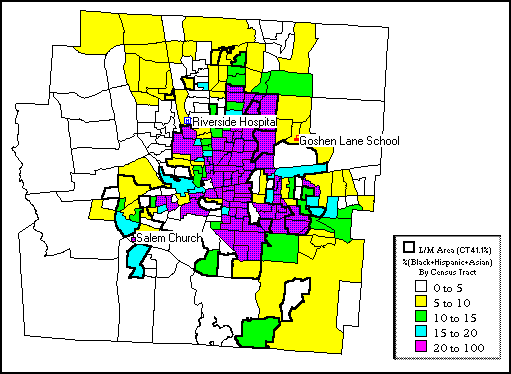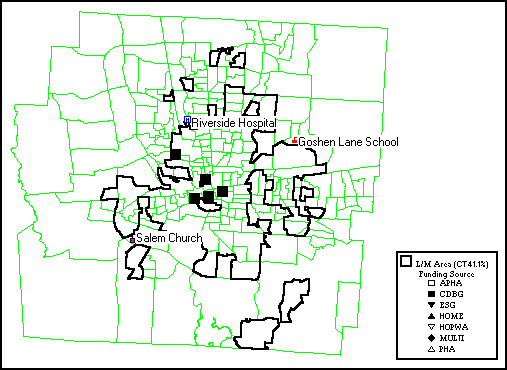

Columbus and Franklin County have enjoyed economic and population growth, which runs counter to state and regional trends. However, the strength of the overall economy is not evenly reflected in all areas of Columbus and the county. Within Franklin County there are very different demographic and housing characteristics. The city and county assessed three geographic areas: the city of Columbus "older city," defined by the 1950 corporate boundaries; the city of Columbus "newer city," made up of areas annexed since 1950; and, the "suburban county," the balance of Franklin County including all of the other cities, villages, and townships except Columbus.
Columbus and Franklin County submitted individual proposed projects for funds they receive from the Department of Housing and Urban Development. Columbus will utilize nearly $14 million in Community Development Block Grant (CDBG) funds, $4.4 million in Home Investment Partnership (HOME) funds, and $342,000 in Emergency Shelter Grants (ESG) in 1995. Franklin County will use $2.9 million in CDBG, $730,000 in HOME, and $88,000 in ESG funds. Together, they will undertake joint strategies to create and conserve existing affordable owner and renter households, to revitalize neighborhood and target areas, to create economic development and job opportunities, and to offer education and supportive service linkages.
Two joint city and county citizen committees—the Consolidated Plan Coordinating Group and CHAS Planning Committee—were used to develop one Consolidated Plan for both the City of Columbus and Franklin County. These committees represent the public, private, and nonprofit groups involved in housing and community development activities in Columbus and Franklin County.
Fifteen community forums were held in suburban Franklin County during August and September 1994. Participants were given information about the Consolidated Plan and the Department of Housing and Urban Development. They were also asked to identify their high-priority housing and community development needs. The Columbus Department of Trade and Development held three community meetings in August 1994 to introduce the new planning process. Information was provided on city housing and community development needs and citizens were given the opportunity to present their ideas.
The major social and economic trends for Columbus and Franklin County are moderate population growth, aging population, dispersion of population to the newer city and suburban county, significant economic growth, a shift from manufacturing to service sector jobs, labor shortages in entry-level jobs, increasing levels of poverty in the older city of Columbus, and increasing rates of teen pregnancy and female-headed households with children.
In 1990 the population of Columbus was 632,910; the total for Franklin County, including Columbus, was 961,437. Between 1980 and 1990, Columbus' population grew by 68,039 and the balance of Franklin County grew by 24,266.
The population for Franklin County is aging. From 1980 to 1990, the county's population age 18 and under grew by just 0.3 percent, but the population age 65 and over increased by 23 percent. Those between 25 and 44 in 1990 made up 29 percent of the population.
A total of 784,320 people in Franklin County are white, 152,840 are black, and 24,898 are from other racial/ethnic groups. The high school graduation ratefor Columbus Public Schools is 46.5 percent, while the rate for all of Franklin County is 65.5 percent. The largest income group in the city is households with incomes between $15,000 and $24,999. In the suburban county, the largest group is households with incomes of more than $50,000.
The poverty level in Columbus for a family of three is $10,560. In 1990, 105,494 people in the city of Columbus were living in poverty. Almost 30,000 Columbus households are considered low income, making less than $18,396 annually. The rest of Franklin county has 8,832 low income households. Extremely low-income households, earning less than $11,938 annually, represent 38,452 households in Columbus and 6,785 in suburban Franklin County. The median family income for Columbus in 1994 was $44,100.


Approximately 6 percent of the 405,418 housing units in Columbus and Franklin County are considered substandard. Within Columbus, an estimated 18 percent of the substandard units are not suitable for rehabilitation, yielding about 14,300 units that are suitable for rehabilitation and 3,150 that are not.
Single individuals are the largest group of renters in Columbus with housing needs; over 23,000 are cost burdened. For elderly renters, nearly 50 percent in Columbus and more than 60 percent in the suburban county experience a housing cost burden. Of the 49,847 small-family and 8,846 large-family renter households in Columbus, 31 percent and 40 percent, respectively are cost burdened.
In Columbus and Franklin County the incidence of housing cost burden and overcrowding is not as great among owner households as it is among renters. Between 15 and 16 percent of all owner households are cost burdened.
According to the 1990 census data, approximately 69 percent of the 405,418 housing units within Franklin County were in Columbus. The number of housing units in Columbus increased by 41,515 between 1980 and 1990 and by 16,337 in the suburban county. A slight majority of occupied units in Columbus are renter-occupied, while more than 70 percent in the suburban county are owner-occupied. The rental vacancy rate in Columbus and Franklin County has fluctuated between 4.3 percent in the third quarter of 1991 and 7.6 percent in the first quarter of 1993. Vacancy rates were generally higher for one- bedroom and lower for three-bedroom apartments. The vacancy rate of owner units for sale is 1.9 percent in Columbus.
Median contract rent (not including utilities) ranges between $290 for the older part of Columbus and $422 for the entire city. The median home value in Columbus is $65,400 compared to $102,675 in the suburban county. A family earning 80 percent of the Columbus area income could, depending on other factors, afford a house costing up to $90,000. At 50 percent of the median income, a family could afford a house valued at about $44,000.
There is a need to:
Emergency shelters in Columbus served about 7,097 individuals in 1993. Women and children comprise 46 percent of the homeless population. About one-third of homeless individuals have a mental disability. Between 30 and 50 percent of the homeless are addicted to alcohol or other drugs. The largest group of people threatened with homelessness, however, is single-parent, female-headed minority households.
The Community Shelter Board has identified 13 organizations in Columbus that provide emergency shelter to the homeless. These shelters have a total nightly capacity of 911 beds that can accommodate 374 single men, 69 single women, 343 families with children, 8 people with a psychiatric crises, 24 public inebriates, 18 youth, and 75 adult overflow or other.
In Columbus and Franklin County, there are 25 organizations providing a total of 759 beds of transitional housing for a variety of client groups. While most of these facilities provide services to homeless people, others provide services to people who have not been homeless.
The Columbus Metropolitan Housing Authority (CMHA) owns and operates 5,104 low- income public housing units in Franklin County. About 90 percent of these units are located in the Columbus older city. These are 61 percent family units and 39 percent units for singles and the elderly.
The county has 3,590 households living in existing Section 8 projects and 516 receiving vouchers. An additional 716 receive Section 8 through Shelter Plus Care and the Section 8 Moderate Rehabilitation Program.
In September 1994 there were 2,040 households on the public housing waiting list and 7,615 households on the waiting list for Section 8 vouchers and certificates. There is some overlap between the two lists, however. Approximately, one-third of the households on the Section 8 waiting list are current public housing tenants.
The Columbus Urban League conducts site test to uncover differences in the treatment of black and white auditors seeking to rent an apartment. The 1991 audit found some differences in the treatment received. Black auditors were more frequently told that their first choice of an apartment was not available, they received higher quotes for the amount of the security deposits, and were told more stringent requirements for leases and credit checks. Most of the problems occur with less sophisticated landlords.
The Urban League also found fairly widespread discrimination in rental housing against families with small children. These families were often told of occupancy limits restricting the number of people per bedroom.
An estimated 167,523 housing units occupied by low- and very low-income households contain lead-based paint. Of those, 76,935 in Columbus and 8,862 in suburban Franklin County are estimated to be renter households, and 74,390 in Columbus and 7,336 in suburban Franklin County to be owner-occupied. Since 1990 the Columbus Health Department has screened 9,543 children for lead poisoning. Of those screened, 2,600 have elevated blood-lead levels.
The community development needs for Columbus and Franklin County were compressed into Columbus Neighborhood Revitalization needs, Franklin County Target Area Revitalization needs, Economic Opportunity and Economic Development needs, and Education and Supportive Service Linkage needs.
Columbus further identified safety, housing development and rehabilitation, city services, code enforcement, and public improvement, neighborhood business, family youth, and supportive service, and community empowerment needs. Franklin County focused on the need for housing, public facilities, public services, infrastructure, and economic development.
Under economic opportunity the city and county jointly identified the need to increase the labor force participation rate in older Columbus, promote job development activities and entrepreneurship. They also identified the need to create linkages to address the needs of education and child care, poverty, teen pregnancy and single parenting, physical and mental health, and crime and violence.
The Consolidated Plan Coordinating Group looked at the Comprehensive Housing Affordability Strategy (CHAS) and the Enterprise Community (EC) Strategic Plan to determine how the EC goals might be changed to reflect the needs of the entire city and county. The following four broad groupings of goals to address the identified needs were developed:
The antipoverty strategy for Columbus and Franklin County is an integral part of the overall strategic plan goals and objectives. Columbus' one-year activities related to reducing the number of households with incomes below the poverty line can generally be found under the plan's Economic Opportunity and Economic Development and Education and Supportive Service Linkages sections.
Specific resources to carry out the plan include Federal, State, county, city, and educational institutions. There also are numerous nonprofit organization involved in housing and community development activities, as well as nonprofit financial institutions, builders and developers, and service providers. Contributions from these sources have been detailed.
The process for developing the Consolidated Plan for Columbus and Franklin County is an interjurisdictional effort coordinated by the Mid-Ohio Regional Planning Commission. The institutional structure through which the city and county will implement the plan includes a wide array of public, private, and nonprofit organizations. The Consolidated Plan Coordinating Group includes representatives of approximately 70 public, private, and nonprofit organizations.
For example, the Columbus Development Department administers the city's housing, neighborhood revitalization, economic development, homeless, and human services programs. Franklin County's housing, homeless, and community development programs are administered by the Mid-Ohio Regional Planning Commission's (MORPC) Department of Housing, Community Development and Weatherization. MORPC administers CDBG, HOME, and ESG programs, among other housing programs.
Lead responsibility for administering programs, projects, and activities related to the CDBG, HOME, and ESG programs is shared between the Columbus Development Department and the Columbus Finance Department.

More than 60 specific projects have been planned for the coming year. These include:
Franklin County activities include
Most activities contained in Columbus are citywide programs that may be used to benefit any eligible individual or household in any eligible area of the city.
To comment on Franklin County's portion of the City of Columbus and Franklin County Consolidated Plan, please contact Linda Donnelly, Director of Housing, Community Development and Weatherization, at 614- 228-2663.